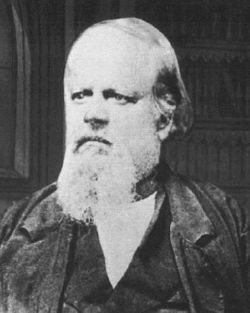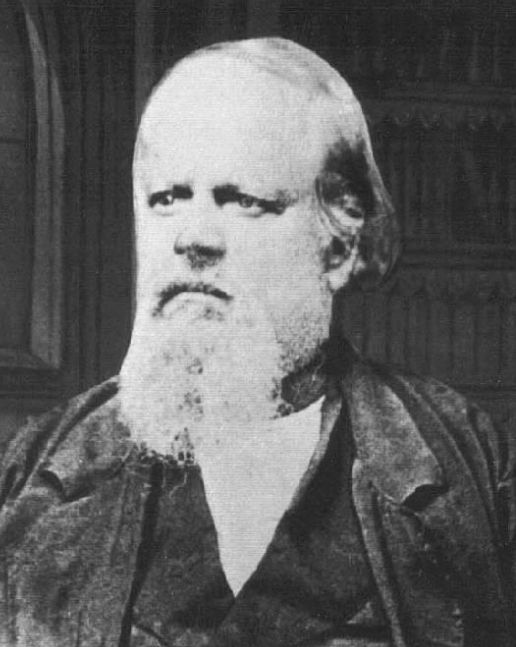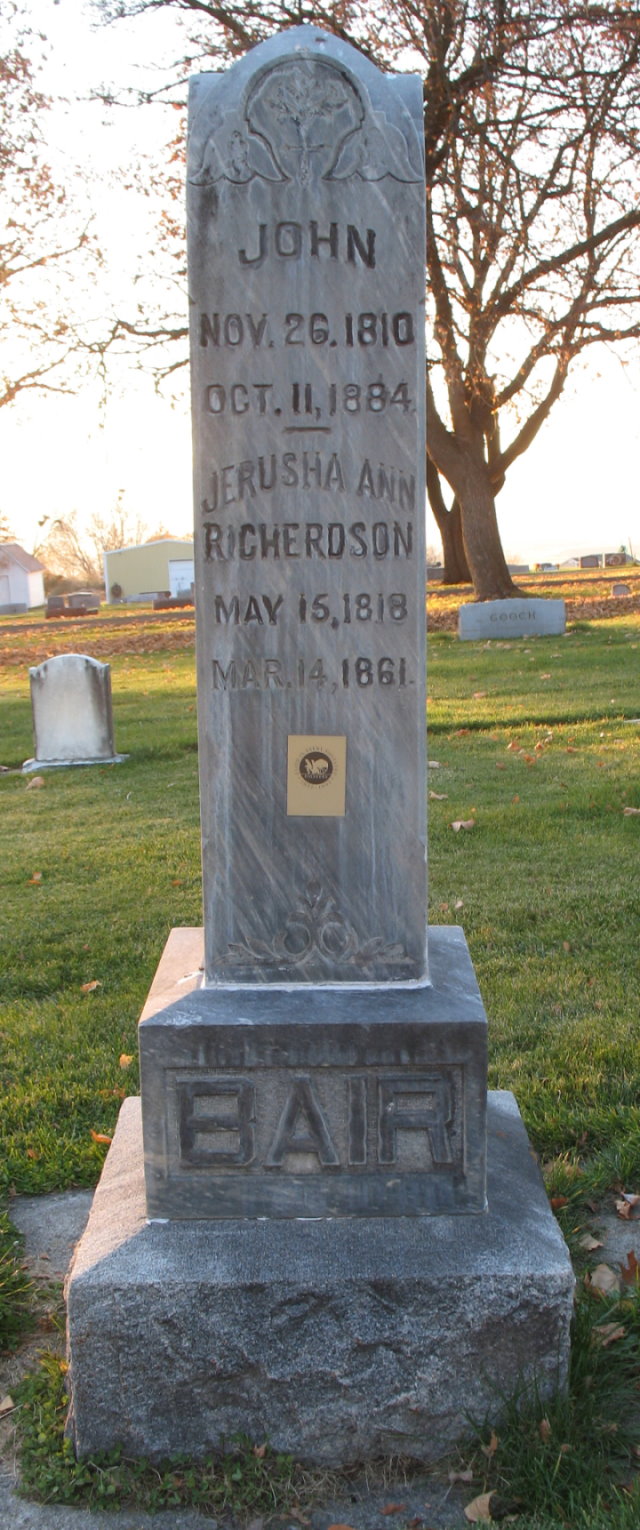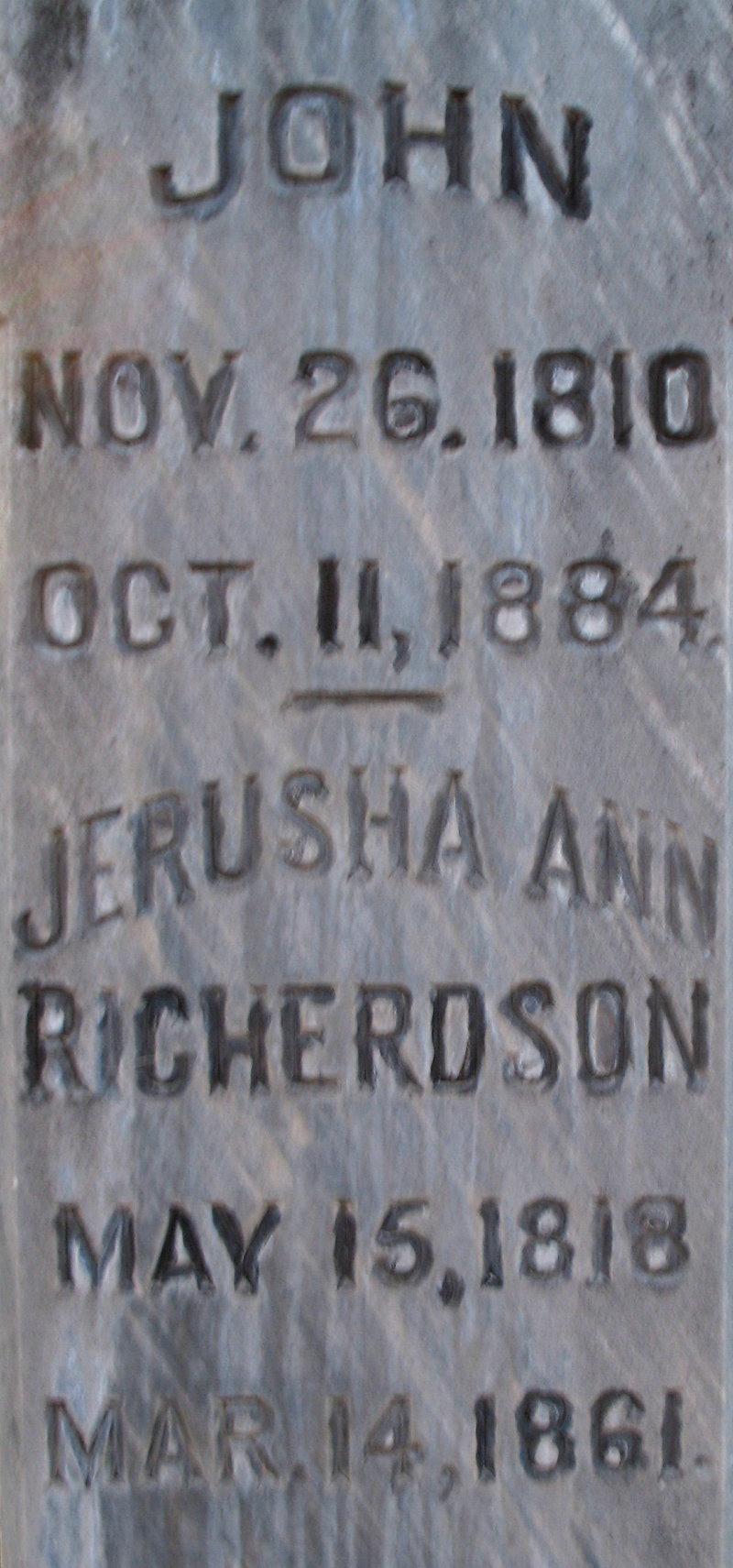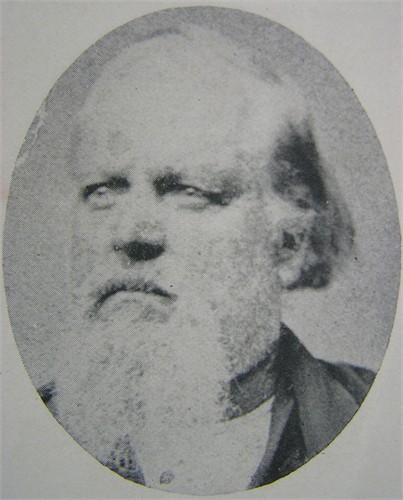Married Lydia Regester, 29 Aug 1829, Lisbon, Columbiana, Ohio, later divorced
Married Lucinda Amanda Owens, 24 Jan 1846, Nauvoo, Hancock, Illinois. Died 4 Jul 1893, Big Piney, Sublette, Wyoming.
Married Jerusha Ann Richardson, 27 Jan 1846, Nauvoo, Hancock, Illinois
Married Belinda Jane Owen, 27 Jan 1846, Nauvoo, Hancock, Illinois
Married Lucy Ann Maria Cole, 1 Jul 1852, Salt Lake City, Salt Lake, Utah
Married Mary Jane Bigelow, 8 Apr 1856, Salt Lake City, Salt Lake, Utah
Pioneers and Prominent Men of Utah, p. 730 ~ Built and operated the first ferryboat in Utah on the Bear river, he also built the first saw mill in Davis county. Settled at Richmond 1859. Took part in Echo canyon war. High priest. Indian war veteran. Shoemaker; lawyer; farmer, and stockraiser. Died Oct. 11, 1884.
Our Pioneer Heritage, Vol. 9, p. 141 ~ Richmond. In July 1859, John Bair with several others, came to Cache Valley and found that settlers had taken up land and had crops growing near Summit Creek, upon which Smithfield was later located. Mr. Bair and his party went farther north and located near a stream which they called City Creek. They commenced to build their log cabins near a large spring, called Brower Springs. Hence, in the fall of 1859, the settlement of Richmond was founded. The winter was very severe, with deep snow making necessary the best of cooperation among the members of the little colony in order for all to survive until the next season.
When Brigham Young visited the settlement, he said the people were too scattered and advised them to construct a fort where they could protect themselves if they were attacked by Indians. "As you are now," said he, "a few Indians could make a raid some night and kill half of you before the other half would know about it."
They followed the President's advice and erected a fort which extended east and west, with a street four rods wide entering the east and west ends. First there was the court, then the water ditch, a small walk in front of the log houses, and back of the houses was a street four rods wide. The fort itself did not have a wall, as the rear of the houses, which were built in a continuous line, served that purpose. All the horses and cattle belonging to the settlers were guarded every night. The fence for the corral was strong and high, made of poles placed together between sets of strong posts. The fort was 300 feet long by 163 feet wide.
Married Lydia Regester, 29 Aug 1829, Lisbon, Columbiana, Ohio, later divorced
Married Lucinda Amanda Owens, 24 Jan 1846, Nauvoo, Hancock, Illinois. Died 4 Jul 1893, Big Piney, Sublette, Wyoming.
Married Jerusha Ann Richardson, 27 Jan 1846, Nauvoo, Hancock, Illinois
Married Belinda Jane Owen, 27 Jan 1846, Nauvoo, Hancock, Illinois
Married Lucy Ann Maria Cole, 1 Jul 1852, Salt Lake City, Salt Lake, Utah
Married Mary Jane Bigelow, 8 Apr 1856, Salt Lake City, Salt Lake, Utah
Pioneers and Prominent Men of Utah, p. 730 ~ Built and operated the first ferryboat in Utah on the Bear river, he also built the first saw mill in Davis county. Settled at Richmond 1859. Took part in Echo canyon war. High priest. Indian war veteran. Shoemaker; lawyer; farmer, and stockraiser. Died Oct. 11, 1884.
Our Pioneer Heritage, Vol. 9, p. 141 ~ Richmond. In July 1859, John Bair with several others, came to Cache Valley and found that settlers had taken up land and had crops growing near Summit Creek, upon which Smithfield was later located. Mr. Bair and his party went farther north and located near a stream which they called City Creek. They commenced to build their log cabins near a large spring, called Brower Springs. Hence, in the fall of 1859, the settlement of Richmond was founded. The winter was very severe, with deep snow making necessary the best of cooperation among the members of the little colony in order for all to survive until the next season.
When Brigham Young visited the settlement, he said the people were too scattered and advised them to construct a fort where they could protect themselves if they were attacked by Indians. "As you are now," said he, "a few Indians could make a raid some night and kill half of you before the other half would know about it."
They followed the President's advice and erected a fort which extended east and west, with a street four rods wide entering the east and west ends. First there was the court, then the water ditch, a small walk in front of the log houses, and back of the houses was a street four rods wide. The fort itself did not have a wall, as the rear of the houses, which were built in a continuous line, served that purpose. All the horses and cattle belonging to the settlers were guarded every night. The fence for the corral was strong and high, made of poles placed together between sets of strong posts. The fort was 300 feet long by 163 feet wide.
Family Members
-
![]()
Lillian Elizabeth Catherine "Lizzy" Bair Osborn
1838–1908
-
![]()
James Robison Bair
1838–1919
-
![]()
Belinda Jane Bair Wall
1848–1924
-
![]()
Lucinda Amanda Bair Sharp
1849–1916
-
![]()
DeLos E. Bair
1850–1904
-
![]()
Hyrum E Bair
1850–1926
-
![]()
Francis Adam "Frank" Bair
1853–1944
-
![]()
Emma Lorena Bair Winn
1854–1927
-
![]()
Moroni Barnet Bair
1857–1937
-
![]()
George Orton Bair
1858–1902
-
![]()
Francis Mariam "Fannie Mae" Bair Edmondson
1859–1935
-
![]()
Rhoda Sabina Bair Moody
1860–1940
-
![]()
Almira Suria Bair Adams
1863–1928
-
![]()
William Alma Bair
1863–1940
-
![]()
Homer Alvin Bair
1867–1941
Advertisement
Records on Ancestry
Advertisement
